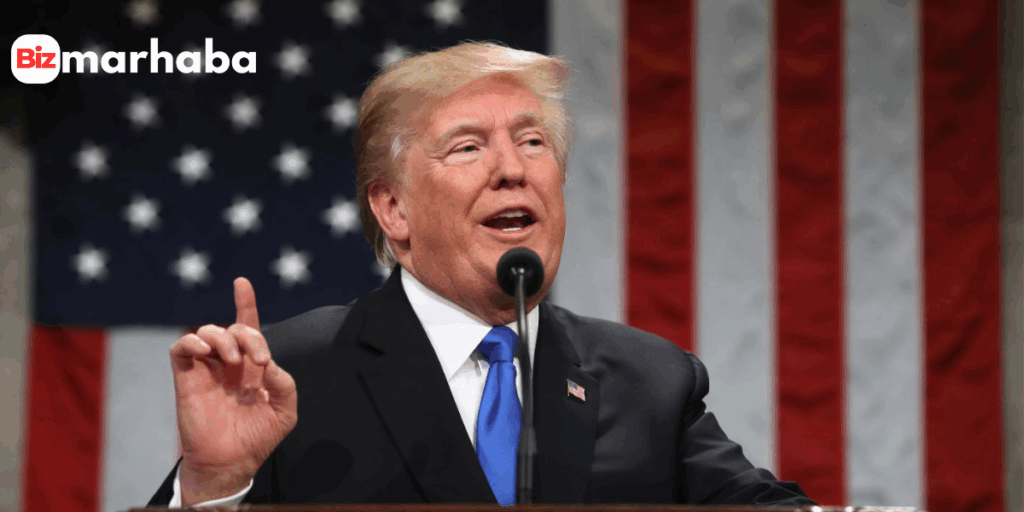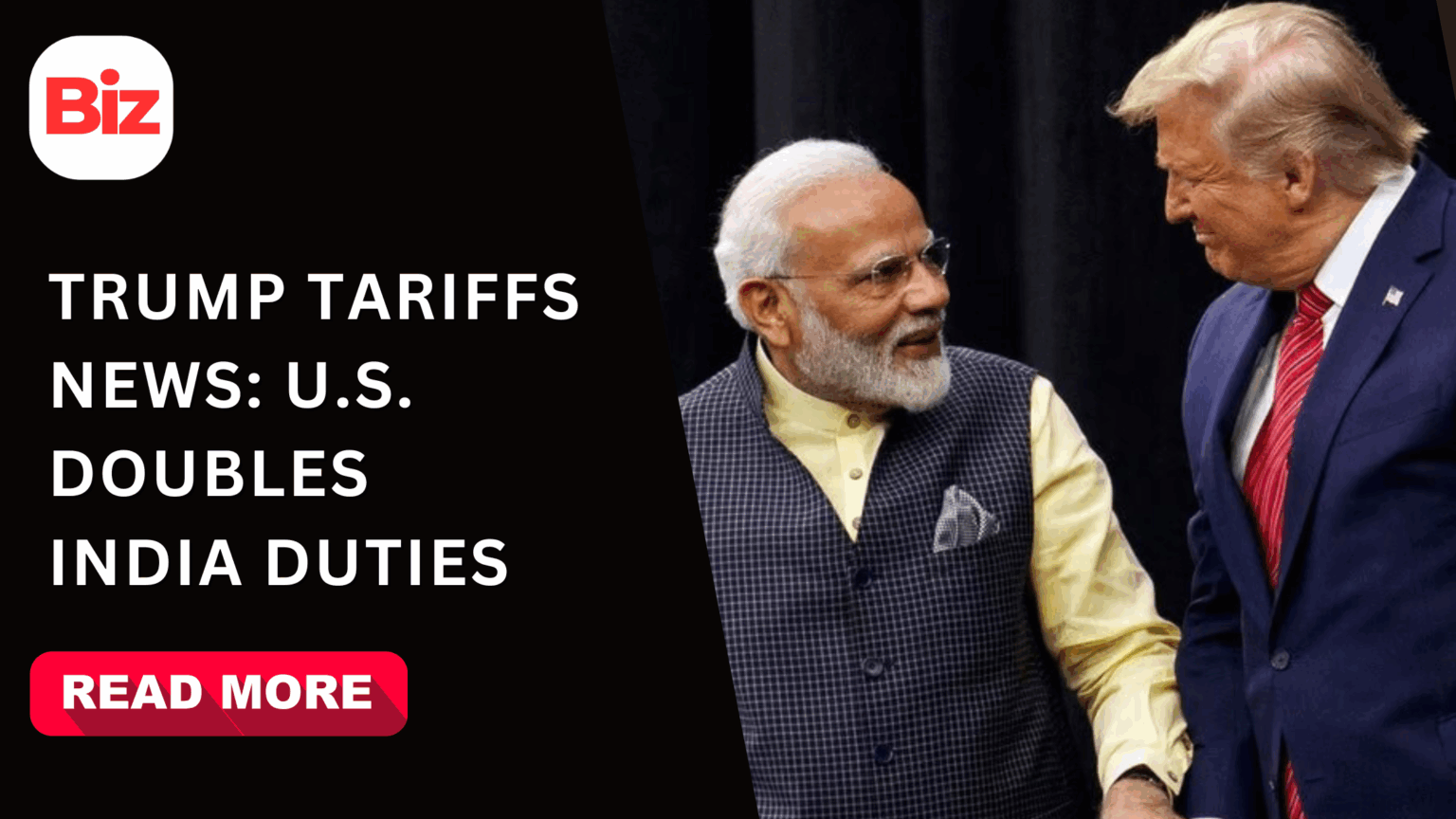- The U.S.-India Trade Relationship Before Tariffs
- Trump’s Doubling of Tariffs on Indian Imports
- Why Did Trump Raise Tariffs on India?
- Impact of Tariff on India by Trump
- India Retaliatory Tariffs Trump
- Global Reactions
- Winners and Losers
- Political Implications
- Conclusion: The Road Ahead for U.S.-India Trade
- FAQs on Trump Tariffs News
The latest Trump tariffs news has shaken up global markets. The U.S. has again increased the tariffs on Indian goods by two times, exerting additional pressure on New Delhi and raising new fears of trade wars. It is billions of dollars of goods that are now at stake and now the economies are holding their reserve.

The U.S.-India Trade Relationship Before Tariffs
The U.S. and India have built one of the fastest-growing trade relationships in the world. In recent years, their two-way trade topped $160 billion annually.
India exported steel, aluminum, textiles and farm products to buyers in America. The U.S. also sold agricultural products, aircraft parts and machinery to India in exchange. On the face of it, the connection was sound.
But friction was building. Washington complained that India blocked American companies with high import duties and complex regulations. India, meanwhile, accused the U.S. of using tariffs to protect its own industries. That tension laid the groundwork for the current clash.
Trump’s Doubling of Tariffs on Indian Imports
When the Trump administration announced the tariff hike, it hit India’s core export sectors, such as:
- Steel and aluminum: A major blow to India’s industrial exporters.
- Textiles: Clothing and fabric makers will now find the U.S. market harder to penetrate.
- Agriculture: Indian farmers could lose competitiveness as their products become more expensive for American consumers.
The jump from 10% to 20% or more on certain goods makes the U.S. a tougher market for Indian businesses. And with billions in trade affected, the impact won’t be small.
Why Did Trump Raise Tariffs on India?
Protectionist Push
The Trump administration embraced protectionism. Officials argued that tariffs were needed to keep American industries safe from foreign competition.
Trade Deficit Concerns
The U.S. trade deficit with India hovered around $25 billion. Trump used this number often as proof that India wasn’t trading fairly. Higher tariffs, in his view, would help balance the books.
Strategic Leverage
There’s also a political side. By hitting India with tariffs, Washington sent a signal: open your markets wider, or face tougher trade rules.
Impact of Tariff on India by Trump
The tariff hike is a headache for Indian exporters. Manufacturers who rely on the U.S. for business could see orders dry up. Smaller companies may feel the pinch the hardest.
American consumers aren’t spared either. Everyday goods from clothing to kitchenware may now cost more. Businesses that depend on Indian imports could also raise prices, passing the burden down the line.
Some U.S. industries, like domestic steel and aluminum, might enjoy less competition. But for most people, tariffs usually mean higher prices and fewer choices.
India Retaliatory Tariffs Trump
India wasted no time in firing back. The government rolled out retaliatory tariffs on U.S. products like apples, almonds, and chemicals.
The message was clear: India won’t sit quietly while Washington turns up the pressure. If the standoff continues, both sides could drag the dispute to the World Trade Organization (WTO).
For more insights on how these moves affect global partners, check out when do Trump’s tariffs hit U.S. trade partners.
Global Reactions
The world is watching this clash closely. Many countries worry that the U.S.-India trade fight could shake supply chains that are already fragile.
Some nations may gain by stepping in to fill gaps in the U.S. market. But overall, the growing number of tariff disputes worldwide adds more uncertainty to global trade.
Winners and Losers
Winners: U.S. domestic producers in steel and aluminum could benefit.
Losers: Indian exporters, American buyers, and small businesses relying on Indian imports are likely to lose out.
Political Implications
In the US, tariffs may help Trump look tough on trade, appealing to workers who fear job losses from imports.
But internationally, this risks straining ties with India, a vital ally in Asia. Trade disputes could spill into defense talks, technology partnerships, and wider diplomatic relations.
Conclusion: The Road Ahead for U.S.-India Trade
The Trump tariffs news is more than an economic story, it’s a political and strategic one, too. Doubling tariffs on Indian imports puts real pressure on New Delhi, but it also risks hurting American consumers and businesses.
If both sides dig in, the trade fight could escalate. India’s retaliatory tariffs already signal a tough stance. Without compromise, the cycle of tariff and counter-tariff may grow, and no one truly wins.
For now, businesses and consumers on both sides of the globe are left waiting and hoping that Washington and New Delhi find common ground before the damage becomes too great.
FAQs on Trump Tariffs News
1. Who benefits from a tariff and who loses?
Domestic producers often benefit because they face less foreign competition. Exporters in the targeted country and consumers in the importing country usually lose, as goods become more expensive.
2. What was the highest tariff in U.S. history?
The Smoot-Hawley Tariff Act of 1930 increased import duties to above 60 per cent on some. As many economists make out, it worsened the Great Depression
3. What are the new U.S. tariffs on Canada?
Canadian steel and aluminum have also been targeted by the U.S. with a tariff action of about 10% or more. These are among the protectionist trade moves by Washington. For updates, check Reuters
4. What is tariff tax in India?
A tariff tax in India is a duty charged on imported goods. It protects local industries and generates government revenue. Rates depend on the type of product.








